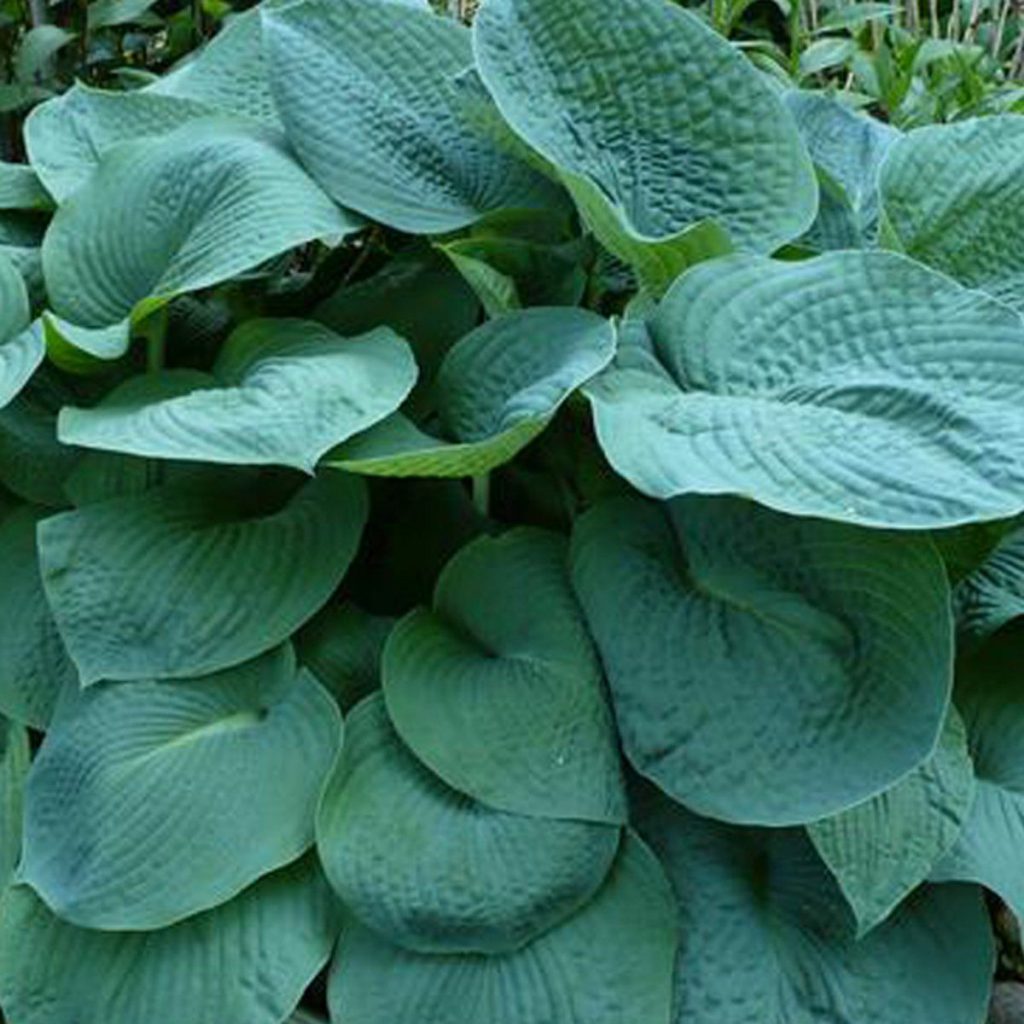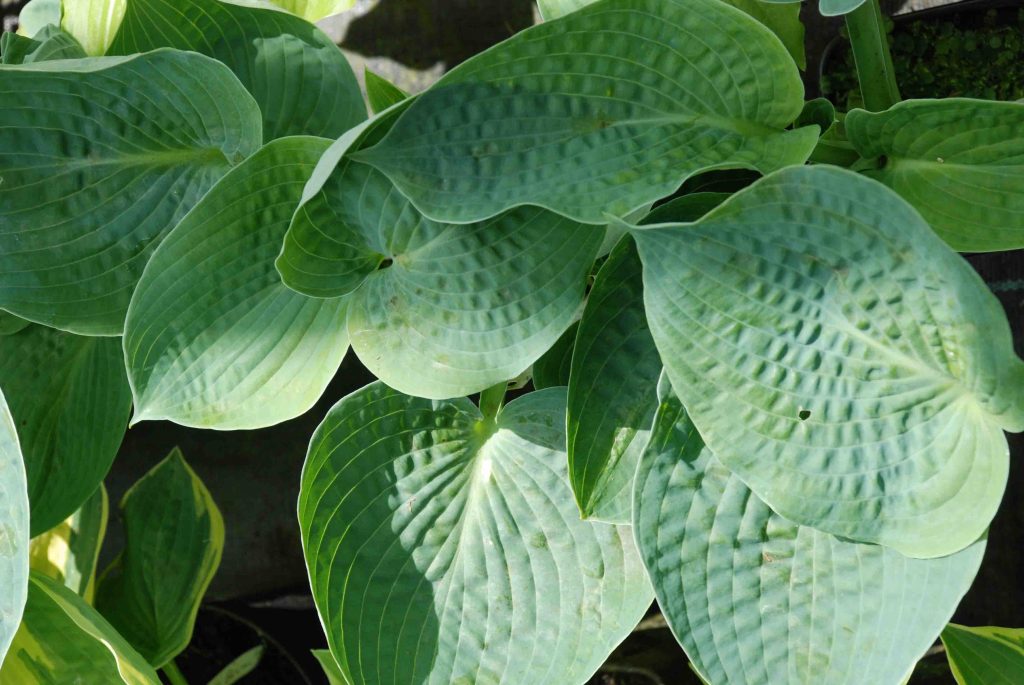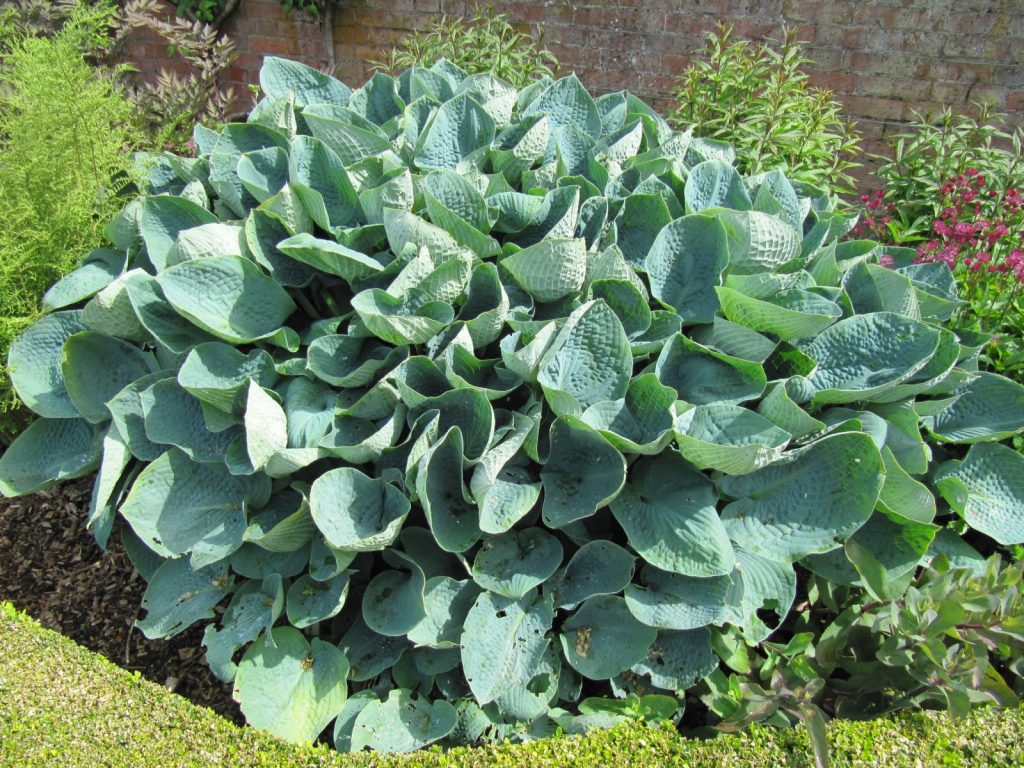Hosta Big Daddy - a blue accent in landscape design
Hosta Big Daddy (Big Daddy) - practically the main among the varieties of this plant species. It is distinguished by its large size and bluish leaves, a high degree of frost resistance and minimal maintenance requirements, due to which the culture has received widespread approval among gardeners. In its natural range, it is found in Southeast Asia, the Far East and Japan. It is used both as an element of landscape compositions and for drawing up floristic bouquets.

Hosta big daddy description
Description of the variety
Big Daddy is a hybrid variety, according to the description of rather large dimensions, capable of growing in height up to 0.6 m with a diameter of 1 m.
The leaves of the plant are large, bowl-shaped, the size fluctuates around 30 * 29 cm. They are painted in a blue tint with a silvery chalk bloom, by the end of the season they turn green noticeably. The sheet plates are dense, have a waffle, slightly wrinkled texture.
In July-August, the bush forms flower stalks 0.7-1.2 m high, with funnel-shaped or bell-shaped white buds located at the tops.
Landing features
The host is unpretentious in leaving. In one place it can grow up to 20 years. In this regard, the choice of a site should be taken seriously, taking into account all the requirements of the culture.
Timing
The most favorable time for planting Big Daddy in open ground is spring, provided there is no threat of frost. Basically, events are held in the last days of April or the first decade of May. At the same time, the soil is prepared in the fall - 10 kg of organic matter is distributed on top and dug to a depth into the bayonet of a shovel.
It is also allowed to carry out works in late August / early September. It is not recommended to plant later, because the seedling will not have time to take root before the onset of frost.
In this case, there is no need to prepare the ground in advance, it is enough to spill the substrate abundantly a couple of hours before the procedure.
Organization of the place
It prefers to settle in shaded areas, where the bluish color of the leaves is more noticeable.
It makes low demands on the soil. However, it is better to give preference to loam, in which more active shrub growth is observed. The substrate should be sufficiently moist, rich in vermicompost with a slightly acidic or neutral medium.
It is also important that the plant is protected from harsh gusts of wind. Therefore, the optimal location is considered to be the north side of the house or the area near the garden reservoir. It should be borne in mind that in conditions of light shade, growth will differ at a moderate speed, and the culture itself will be large in size.
Preparation of planting material
When purchasing a host through an online catalog, it is worth choosing from the list those copies that do not have an aboveground part, which should be inquired about from the supplier of the goods in advance.If a seedling has at least a few leaf plates, the likelihood that it will take root is reduced, because there is a load on the rhizome.

Hosta x big daddy
If the planting material did not arrive on time, and the soil has not yet been prepared, it is necessary for the first time to transplant the culture into a regular container. Presented only with a spine without a growth bud, it is allowed to be stored in the refrigerator until embedded in the substrate.
Landing technology
Hosta Big Duddy is planted according to the following process description:
- They dig a planting hole that is 2 times larger than the root system. When planting a group of plants, a step of 0.8-1.0 m is maintained.
- Water abundantly.
- A seedling or plot is installed, the roots are carefully straightened.
- Peat is added to the garden soil, after which the bush is sprinkled with the resulting soil mixture. Slightly tamp, trying not to deeply deepen the plant - the root collar should be flush with the surface.
- Re-watered. If the soil has subsided, it is additionally poured.
- Mulch with sawdust or crushed bark.
Care
Watering
Given that the hosta has large leaves, from which moisture is actively evaporated, the plant should be watered daily in summer. Irrigate the soil under the root, trying to avoid getting liquid on the aboveground part.
Otherwise, the risk of sunburn by shrubs increases. It is recommended to carry out the procedure in the morning until 11 o'clock, if necessary - at lunchtime, but only if the weather is cloudy.
Top dressing
If fertilizers were applied to the substrate during planting, then the first 3-4 years you can not worry about feeding. In the future, the culture is fertilized 2-3 times per season: at the initial stage of the growing season and at the end of flowering.

Hosta big daddy
The main food is organic matter - rotted manure or humus, often used for mulching. Additionally, granular mineral complexes with potassium, phosphorus, nitrogen included in the composition are distributed over the surface, after which the soil is abundantly moistened.
Mulching and loosening
Young plants, which are not able to resist the rapid growth of weeds, need most of all to loosen the substrate. As the shrub develops and grows, the need for these procedures disappears.
Mulching is done annually, which prevents evaporation of moisture from the ground and ensures uninterrupted nutrition of the plant.
Reproduction
Seeds
At the end of flowering, seed boxes are formed on the host, from which the seed is collected. The disadvantage of this method is the complexity of the procedure and the loss of varietal characteristics.
Before planting in the ground, the seeds are necessarily treated with a growth stimulant and disinfected in a weak solution of potassium permanganate. The soil mixture is made from peat, vermiculite or perlite, pre-calcined in the oven. The containers are also sterilized.
In April-May, seeds are embedded in the substrate to a depth of no more than 7 mm, after which the container is covered with polyethylene and kept at a temperature of 20 ° C. The first shoots appear after a few weeks, the pick is done at the stage of 2 true leaves.
Before being transported to the flower bed, the seedlings are hardened, temporarily exposed to the open air.
Cuttings
The plant is propagated by cuttings in the middle of summer, in the month of June and July. Strong shoots with leaves and a heel are taken as a material, which are cut off with sharp scissors.

Big Duddy Hosta Photo
Additionally, the sheet plates are shortened by ⅓, thus reducing the evaporation of moisture.
After the sprouts are planted in a shaded place and watered daily. Initially, the seedlings may look lethargic, but after a while the turgor is restored as the young plants take root.
Dividing the bush
Rhizome division is the most productive method of Khost breeding, which is recommended either in early spring or in autumn.
During the procedure, the shrub is completely dug out of the ground and divided into several segments, the sections are treated with crushed activated carbon or wood ash.
Additionally, injured and affected roots are cut off, and the plots are determined to a permanent place. The rooting process takes about 2 weeks.
Diseases and pests
| Disease / Insect | Symptoms | Prophylaxis | Treatment |
| Slugs / snails | Initiated by visual inspection, eaten edges and holes appear on the leaves. | Mulch the soil (mulch complicates the movement of gastropods). Sheets of roofing material or slate are stuck along the perimeter of the flower bed, at the base of which parasites hide in the heat, then they are collected by hand. Bottles with a small amount of beer are placed around the territory, when insects gather in them, they are disposed of. Crushed eggshells are scattered over the surface. | Folk methods: Impregnate sawdust for mulch with essential oils of lavender, laurel, sage. Chemicals: EcoKiller, Ferramol, Hunter, Thunderstorm, Ulicid, Slug-eater, Antislime, Predator. |
| Rodents | Sharp wilting of the plant. Lack of young growth in the new season. | They are planted in specialized protective nets. | Set up traps, treat with chemicals: Coumarin, Warfarin, arsenic. |
| Caterpillars | Deterioration of the condition of the bush, insects are noticeable upon visual inspection. | They dig in the area from all sides, thus creating protective grooves, which greatly complicates the penetration of caterpillars into the garden. | Folk methods: infusion of tobacco, pharmacy chamomile, yarrow, decoction on tomato tops. |
| Nematode | Suspension in growth, in hot weather the leaves are deformed, swelling appears on the roots. | Plants are regularly weeded, water is avoided on the leaf plates during watering, marigolds / marigolds are planted between rows, and plant residues are disposed of. | Purchased drugs: Pecilomycin, Metarizin, Phytochit, Basomil. Chemicals: Carbation, Phosphamide, Lindane, Dimethoate. |
| Phylostictosis | The spotting on the surface of the leaves is brown or light gray; as the disease progresses, it grows, holes appear in the center. | Avoid excessive waterlogging, regularly treat with Fitosporin. | Cut off the affected areas, sprinkle the wound with activated carbon powder. Purchased drugs: Vectra, Abiga-Peak, Strobi, Ixtra. |
| Anthracnose | Brown spots up to 12 mm in diameter, have a clear outline and a dry, cracked surface. In shape, they resemble a trail of raindrops. | Refrain from planting in an alkaline substrate, apply phosphorus-potassium fertilizers on time, avoid damage during the transplantation process. | Purchased funds: Ridomil Gold MC, Fundazol, Skor, Previkur, Acrobat MC. |
Use in landscape design
In landscape design, Hosta is most often used to create borders, because it can grow in one place for many years. With their help, it is also possible to create beautiful carpet plantings or to add a bright touch in the middle of the flower bed.

Hosta hybrid big daddy
The shrub looks great in mixborders next to large plants such as balsams, daylilies or irises.In this case, there will be no pronounced difference in size, but a contrast between the bluish greens of Big Daddy and other flowers will visually appear. The culture is effectively combined with conifers with a crown of a similar shade - juniper, yew, fir or blue spruce.
Also suitable for decorating garden ponds, streams, fountains, complemented by sedge, fern or rhododendron. Fans of more original compositions can decorate the adjacent space with a suitable driftwood and emphasize the laconicism with gravel chips.
When choosing a permanent companion for Hosta, it is recommended to give preference to those specimens that actively manifest themselves in the spring, which will revive the design of the site, regardless of the season.
Testimonials
Gardeners speak only positively about Hosts, these plants are not capricious and require minimal maintenance, which at the same time does not compromise decorative qualities.
At the same time, the Big Daddy variety is distinguished against the background of other blue varieties as one of the most attractive and large.
Experienced agronomists recommend purchasing seedlings only from trusted suppliers, noting the frequent discrepancy between the varietal characteristics of the purchase.

